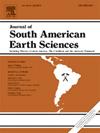Coastal spatial planning using object-based image analysis and image classification techniques
IF 1.7
4区 地球科学
Q3 GEOSCIENCES, MULTIDISCIPLINARY
引用次数: 0
Abstract
This study focuses on optimizing coastal spatial planning for Rio de Janeiro, Brazil, addressing critical challenges such as unmanaged urbanization, loss of natural habitats, and land degradation. Utilizing Object-Based Image Analysis (OBIA) and Image Classification techniques within QGIS, the research examines Land Use/Land Cover (LULC) data from 2005, 2015, and 2024. Using the Molusce tool for spatial modeling, land use patterns were predicted for 2035 and 2045. Key spatial parameters analyzed include proximity to rivers, land value, slope level, and population density. Significant trends include a decline in water bodies (3.70% in 2005 to 2.70% in 2045), a surge in built-up areas (29.33%–43.99%), and a reduction in forest cover (38.70%–30.26%). Additionally, barren land is expected to increase from 6.26% to 15.35%, reflecting environmental degradation, while agricultural land shows a steep decline (21.32%–5.59%), driven by urban sprawl and economic shifts. Salt pans, though minimal, are projected to rise from 0.69% to 2.11%. These changes highlight pressing issues like habitat destruction, declining agricultural land, and rising urban pressures in the region. The study underscores the importance of integrated coastal management strategies to balance development and sustainability. Predictive modeling tools in QGIS provide actionable insights for policymakers to anticipate land use changes and implement proactive measures for urban and environmental planning.
求助全文
约1分钟内获得全文
求助全文
来源期刊

Journal of South American Earth Sciences
地学-地球科学综合
CiteScore
3.70
自引率
22.20%
发文量
364
审稿时长
6-12 weeks
期刊介绍:
Papers must have a regional appeal and should present work of more than local significance. Research papers dealing with the regional geology of South American cratons and mobile belts, within the following research fields:
-Economic geology, metallogenesis and hydrocarbon genesis and reservoirs.
-Geophysics, geochemistry, volcanology, igneous and metamorphic petrology.
-Tectonics, neo- and seismotectonics and geodynamic modeling.
-Geomorphology, geological hazards, environmental geology, climate change in America and Antarctica, and soil research.
-Stratigraphy, sedimentology, structure and basin evolution.
-Paleontology, paleoecology, paleoclimatology and Quaternary geology.
New developments in already established regional projects and new initiatives dealing with the geology of the continent will be summarized and presented on a regular basis. Short notes, discussions, book reviews and conference and workshop reports will also be included when relevant.
 求助内容:
求助内容: 应助结果提醒方式:
应助结果提醒方式:


